Click on images to enlarge
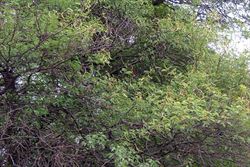
habit (Photo: Sheldon Navie)
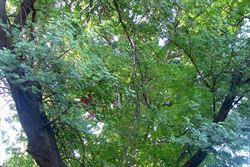
habit (Photo: Sheldon Navie)
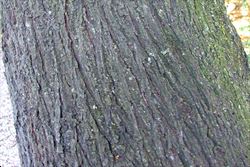
rough, fissured, bark on main trunk (Photo: Sheldon Navie)

younger branch with large paired spines (Photo: Sheldon Navie)
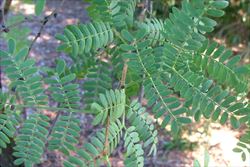
twice-compound leaves (Photo: Sheldon Navie)

close-up of leaflets (Photo: Sheldon Navie)
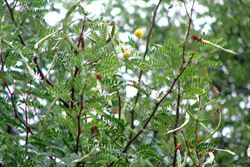
old flower clusters and immature fruit (Photo: Sheldon Navie)

curved immature and mature fruit (Photo: Sheldon Navie)

close-up of immature and mature fruit (Photo: Sally Vidler)
Scientific Name
Vachellia karroo (Hayne) Banfi & Galasso
Synonyms
Acacia karroo Hayne
Acacia dekindtiana A. Chev.
Acacia eburnea sensu auct.
Acacia hirtella E.
Mey.
Acacia horrida sensu auct. mult. non (L.)
Willd.
Acacia inconflagrabilis Gerstner
Acacia karoo Hayne, ortho. var.
Acacia natalitia E. Mey.
Family
Fabaceae: sub-family Mimosoideae (New South Wales)Leguminosae (South Australia)Mimosaceae (Queensland, the ACT, Victoria, Tasmania, Western Australia and the Northern Territory)
Common Names
Cape gum, Cape thorn tree, gum arabic tree, karroo thorn, karroothorn, mimosa thorn, sour thorn, sweet thorn, sweet thorn acacia, sweet-thorn, umbrella thorn, white thorn, whitethorn
Origin
Native to large parts of southern Africa (i.e. South Africa, Lesotho, Swaziland, Botswana, Namibia, Angola, Malawi, Mozambique, Zambia and Zimbabwe). It is very common in its native range and is probably southern Africa's most common tree.
Cultivation
This species has occasionally been cultivated in the southern regions of Australia. It is sometimes grown as a garden ornamental, but is more commonly found in botanic gardens, zoos and wildlife parks. Plants are sometimes grown in botanic gardens as a typical representation of the flora of the savannas of southern Africa, while specimens in zoos and wildlife parks are grown to provide fodder and habitat for African animals. Cultivated specimens have been recorded in South Australia (near Port Augusta, in the Adelaide Botanic Gardens and in the Waite Arboretum in Adelaide), Western Australia (at Kings Park in Perth), New South Wales (at Stockton and at the Western Plains Zoo in Dubbo), and Victoria (at the Werribee Open Range Zoo and the Melbourne Zoo).
Naturalised Distribution
Karroo thorn (Vachellia karroo ) has not yet become widely naturalised in Australia. It has been recorded as being naturalised in several sites near Perth in south-western Western Australia and has spread from plantings in the Western Plains Zoo at Dubbo, in western New South Wales. There are also reports of it being present in the Northern Territory and the ACT, however these may refer to cultivated specimens and not naturalised individuals. All of these known naturalised populations have been 'eradicated', and most of the known cultivated individuals have been destroyed. The two occurrences in Queensland are also under eradication.
Karroo thorn (Vachellia karroo) has also become naturalised in other parts of the world, including northern Africa (i.e. Libya and Morocco), southern Europe (i.e. Spain, Portugal, Corsica and Sicily), South America (i.e. Bolivia and Chile), Iraq and Mauritius.
Habitat
This species is a potential weed of grasslands, open woodlands and pastures in the semi-arid, temperate and sub-tropical regions of Australia. The naturalised populations found in Western Australia were usually growing along riverbanks.
In its natural environment, in southern Africa, it is often found growing by watercourses (particularly in lower rainfall areas) and in valleys.
Habit
A large thorny shrub or small tree usually growing 3-10 m tall, but occasionally reaching up to 15 m in height. However, very old trees have been reported to reach 25 m in height in southern Africa. When growing in cooler and drier regions, plants may lose all of their leaves during winter (i.e. it can be deciduous).
Distinguishing Features
- a thorny shrub or tree with twice-compound leaves.
- it has a pair of large, straight, whitish-coloured spines (up to 25 cm long) near the base of each leaf.
- its yellow or golden-yellow flowers are borne in small dense globular clusters (10-15 mm across) in the leaf forks.
- its large, elongated and flattened pods (6-16 cm long) are curved or sickle-shaped in nature.
Seedling
Seedlings have two undivided seed leaves (i.e. cotyledons). The first true leaves are usually twice-compound (i.e. bipinnate), but usually have only one or two pairs of branchlets (i.e. pinnae), each bearing several pairs of tiny leaflets (i.e. pinnules).
Stems and Leaves
The bark of the main trunk and older branches is dark reddish-brown to blackish in colour, rough in texture and deeply fissured. Younger branches are usually reddish in colour, while the growing tips are bright green and either hairless (i.e. glabrous) or rarely sparsely hairy (i.e. puberulent). The branches bear many large straight thorns that are usually about 7-10 cm long, but may occasionally reach up to 25 cm in length. These thorns are borne in pairs in the forks (i.e. axils) of the leaves and are greyish or whitish in colour with darker tips. Thorns are usually longer, stronger and more abundant towards the base of the plant, but may be absent from the trunks of older trees.
The leaves are twice-compound (i.e. bipinnate), have a ferny appearance, and are dark green in colour. These leaves (up to 12 cm long) are alternately arranged along the stems and borne on a stalk (i.e. petiole), which may or may not have a large raised structure (i.e. gland) on its upper side. The extension of the leaf stalk (i.e. rachis) bears 2-7 pairs of smaller leaf branchlets (i.e. pinnae). This leaf stalk extension is 1-5 cm long and bears a small raised structure (i.e. gland) at the junction of some or all of the pairs of leaf branchlets (i.e. pinnae). The leaf branchlets each bear numerous (5-27) pairs of small leaflets (i.e. pinnules) that are oblong in shape. These leaflets (3.5-8 mm long and 1-3 mm wide) are hairless (i.e. glabrous) or rarely have tiny hairs (i.e. cilia) along their margins. They are entire and their tips are rounded (i.e. obtuse) or occasionally somewhat pointed (i.e. sub-acute).
Flowers and Fruit
The small yellow or golden-yellow flowers are sweetly scented and densely arranged into small globular clusters (8-15 mm across). Each individual flower has five relatively inconspicuous petals and sepals and numerous conspicuous stamens that give the flower clusters a very fluffy appearance. The globular flower clusters may contain up to 90 of these tiny flowers and are borne in groups of 4-6 on stalks (i.e. peduncles) emanating from the leaf forks (i.e. axils) that are 7-24 mm long. However, sometimes the leaves may be absent from the tips of the flowering branches and the flower clusters may appear to be arranged into larger inflorescences (i.e. leafless terminal 'racemes'). Flowering occurs mostly during summer.
The fruit are large crescent-shaped or sickle-shaped (i.e. falcate) pods, that are somewhat flattened and often have slight constrictions between each of the seeds. These pods are long and slender (60-160 mm long and 6-10 mm wide), smooth in texture, and hairless (i.e. glabrous). They are green and shiny when young, but turn brown as they mature and eventually split open at maturity to release their seeds. The seeds are olive-green to brown in colour and either oblong, oval (i.e. elliptic) or lens-shaped (i.e. lenticular). These seeds (4.5-8 mm long and 2-5 mm wide) are also somewhat flattened and attached to the pod by a thread-like stalk (i.e. aril).
Reproduction and Dispersal
This plant reproduces by seed, however stumps are known to coppice readily after trees have been lopped. The hard seeds are long-lived, and buried seeds are reported to remain viable in the soil for up to 7 years.
Seeds are most commonly dispersed when the pods are eaten by animals (e.g. cattle and birds), which later pass the seeds in a viable condition. They may also be dispersed by wind or water.
Environmental Impact
Karroo thorn (Vachellia karroo) is on the Alert List for Environmental Weeds, a list of 28 plants that threaten biodiversity and have the potential to seriously degrade Australia's ecosystems. Though this species is not yet well established in Australia, it has the potential to invade grasslands and rangelands over much of southern Australia and become a major woody weed in this country. It has the ability to establish and form dense thickets or monocultures in native vegetation and may exclude existing native grasses and other native vegetation in certain areas. Areas of open vegetation in southern Australia, where the annual rainfall is below 1000 mm, are considered most at risk from this species.
In its native homeland in southern Africa, this species is the most important woody invader of grazing lands and native grassland vegetation, and in some areas it occurs as a dominant part of river bed vegetation. Karroo thorn (Vachellia karroo) is a pioneer species and generally invades disturbed areas. Its invasion in southern Africa is thought to largely be a result of the reduction in competition between grasses and woody plants as a result of overgrazing.
Other Impacts
This species also has the capacity to reduce agricultural productivity in affected areas by replacing pasture grasses, preventing stock movement and inhibiting mustering activities. As a result, it has been placed on the national exotic pest plant list, a list of potential weeds that have been identified as a serious concern to Australia’s plant industries.
Legislation
This species is declared under legislation in the following states and territories:
- New South Wales: Class 1 - a state prohibited weed. The presence of the weed on land must be
notified to the local control authority and the weed must be fully and
continuously suppressed and destroyed (throughout the entire state).
- Queensland: Class 1 - introduction into the state is prohibited, and landowners must
take reasonable steps to keep land free of this species (throughout the entire
state). It is also illegal to sell a declared plant or its seed in this state.
- Victoria: S -
prohibited entry into the state and to be eradicated from the state if
possible.
- Western Australia: P1 - trade, sale or movement into the state prevented, and P2 - to be eradicated (throughout the state). Note: All non-indigenous species of Acacia are declared in this state, except mimosa bush (Vachellia farnesiana).
Management
For information on the management of this species see the following resources:
- the Victorian Department of Primary Industries Landcare Note entitled Karoo Thorn and Giraffe Thorn: State
Prohibited Weeds, which is available online at http://www.dpi.vic.gov.au.
- the New South Wales Department of Primary Industries Noxious and Environmental Weed Control Handbook, which is available online at http://www.dpi.nsw.gov.au
- the Biosecurity Queensland Fact Sheet on this species, which is available online at http://www.daff.qld.gov.au.
Similar Species
Karroo thorn (Vachellia karroo) may be confused with prickly acacia (Vachellia nilotica), mimosa bush (Vachellia farnesiana ), the mesquites (Prosopis spp.), cutch tree (Senegalia chundra) and kangaroo thorn (Acacia paradoxa). These species can be distinguished by the following differences:
- karroo thorn (Vachellia karroo) is a thorny plant with twice-compound (i.e. bipinnate) leaves
having few to several (2-7) pairs of branchlets. Its fluffy bright yellow
flowers are borne in small globular clusters (8-15 mm across) in the
upper leaf forks (i.e. axils). The large fruit are elongated pods (6-16 cm
long and 6-10 mm wide) that are somewhat flattened and either sickle-shaped or
curved. These pods are smooth and hairless (i.e. glabrous), have slight
constrictions between each of the seeds, and turn dark brown in colour as they
mature.
- prickly acacia (Vachellia nilotica) is a thorny plant with twice-compound (i.e. bipinnate) leaves
having several to numerous (3-10) pairs of branchlets. Its fluffy bright
yellow flowers are borne in small globular clusters (10-12 mm across) in
the upper leaf forks (i.e. axils). The large fruit are very elongated pods
(6-25 cm long and 4-17 mm wide) that are somewhat flattened and either
straight or slightly curved. These pods are softly hairy (i.e. pubescent),
strongly constricted between the seeds (i.e. torulose), and turn greyish-green
to brownish-green in colour as they mature.
- mimosa bush (Vachellia farnesiana ) is a thorny plant with twice-compound (i.e. bipinnate) leaves
having few (2-4) pairs of branchlets. Its fluffy bright yellow flowers
are borne in small globular clusters (11-15 mm across) in the upper leaf
forks (i.e. axils). The large fruit are somewhat elongated pods (5-7 cm long
and 12-15 mm wide) that are almost cylindrical and either straight or slightly
curved. These pods are hairless (i.e. glabrous), do not have any obvious
constrictions between each of the seeds, and turn dark brown or black in
colour as they mature.
- the mesquites (Prosopis
spp.) are thorny plants with twice-compound (i.e. bipinnate) leaves having few
(1-5) pairs of branchlets. Their fluffy pale yellow, yellow, greenish-yellow
or whitish coloured flowers are borne in elongated clusters (5-14 cm
long) in the upper leaf forks (i.e. axils). The large fruit are very elongated
pods (8-20 cm long and 7-15 mm wide) that are almost cylindrical and either
straight or somewhat curved. These pods are mostly hairless (i.e.
glabrous), have slight constrictions between each of the seeds, and turn
yellowish or purplish in colour as they mature.
- cutch tree (Senegalia chundra) is a thorny plant with twice-compound (i.e. bipinnate) leaves
having numerous (7-24) pairs of branchlets. Its fluffy pale yellow or whitish
coloured flowers are borne in elongated clusters in the upper leaf forks
(i.e. axils). The large fruit are elongated pods (5-12.5 cm long and 15-20 mm
wide) that are flattened and either straight or slightly curved. These pods
are hairless or softly hairy in the lower part, do not have any obvious
constrictions between each of the seeds, and turn dark brown in colour as they
mature.
- kangaroo thorn (Acacia paradoxa) is a thorny plant with relatively small simple 'leaves' (i.e. phyllodes). Its fluffy bright yellow flowers are borne in small globular clusters (8-12 mm across) in the upper leaf forks (i.e. axils). The fruit are relatively small somewhat elongated pods (4-7 cm long and 3-5 mm wide) that are almost cylindrical and either straight or slightly curved. These pods are densely hairy (i.e. pubescent), do not have any obvious constrictions between each of the seeds, and turn brown in colour as they mature.
Karroo thorn (Vachellia karroo) may also be confused with several other native wattles (Acacia spp.). However, none of the native wattles have a pair of very large spines at the base of each leaf (i.e. the native wattles are usually either spineless or have small spines or thorns).
Note: This page only covers those species that have been reported to be confused with karroo thorn (Vachellia karroo). For a more in-depth key to all of the wattles (Acacia spp.) present in Australia, see the Wattle: Acacias of Australia CD-ROM or Flora of Australia, Volumes 11A and 11B.

